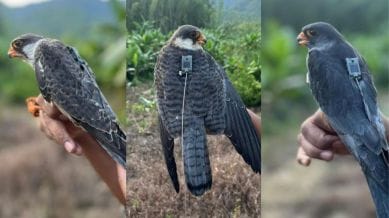Stay updated with the latest - Click here to follow us on Instagram
6,000 km in six days: How WII tracked a trio of Amur falcons across continents
Through the week, Supriya Sahu, Additional Chief Secretary Environment Climate Change & Forests, Government of Tamil Nadu, posted updates on the birds’ flight on her X handle.

Every year, tens of thousands of Amur falcons lift off from Northeast India and push through what is still one of the most extreme nonstop migrations recorded: 5,000-6,000 km in five to six days, often without touching land until they reach Africa.
This season, the Wildlife Institute of India (WII) fitted three Amur falcons with transmitters to track their flight in real-time before their signals reappear on African soil.
The 3 birds that crossed continents
WII officers tagged the birds in Tamenglong on November 11 using transmitters weighing around 3.5g – 4g, said senior scientist, WII, Dr Suresh Kumar. “A general rule of thumb while fitting a foreign object, is that it must weigh less than 3% of the bird’s body weight,” he said. Once equipped with the transmitters, the birds took off the very next day.
Apapang, an adult male marked orange (on the map below), was the first to commit to the crossing. In just days, Apapang has cut across central India and skimmed the Arabian Sea, flying 6,100 km in six days and eight hours.
Alang, a young female (tagged yellow), took a similar line and clocked 5,600 km in six days and 14 hours.
Ahu, an adult female, (red), cut into Bangladesh, crossed the fields near Sylhet and then hit the Arabian Sea late. Five days later, after 5,100 km, she landed on the Horn of Africa.
Through the week, Supriya Sahu, Additional Chief Secretary Environment Climate Change & Forests, Government of Tamil Nadu, posted updates on the birds’ flight on her X handle. “You will see that while Ahu continues to move around in northern Somalia, both Apapang and Alang have moved on into Tanzania and Kenya respectively. Ahu has stopped at Somalia which is not surprising as they generally do after a long flight. Falcons start to feed again to put on fat reserves that they exhausted during their overseas migration,” she posted on X.
The three falcons will now remain in Africa for the winter.
A project born from a crisis
“The current tracking project was born of a need to conserve Amur falcons being hunted down in parts of Northeast India,” says Kumar.
In 2012, Pangti village in Nagaland witnessed large-scale commercial hunting of Amur falcons. “This was a protected species, and India being a signatory to the Convention on Migratory Species, we had to look for ways to conserve the species” the WII scientist said. This led to a coordinated push by WII, state forest departments and local communities.
The tracking project had formally begun by 2013, designed to also document stopovers, reduce threats, and raise awareness across local communities in multiple states including Nagaland, Manipur and Assam.
“Our goal was to understand migratory patterns and stopover sites,” he said. “It also helped communicate a bigger story, to instil pride in local communities.”
Most of WII’s tracking projects named birds after villages in Northeast India, “meaning with increased attention to the projects and the feats of these birds, the names of the villages would travel far and wide.”
Why the raptors stop in Northeast India
Understanding migratory routes of these Amur falcons that travel long without so much as a break begs the question of why these birds stop in specific places. “The next question I had after observing the patterns of these birds is why the falcons spend 15–20 days (around two to three weeks) in districts such as Dimahasao,” said Kumar.
Co-authoring a paper titled ‘Prey Species in the Diet of the Amur Falcon (Falco amurensis) During Autumn Passage Stopover in Northeast India’, Kumar explains, “They’re feeding on termites. It’s high-protein migration fuel. The birds fatten up rapidly here to ensure they make it through their flight.”
“Their arrival coincides with the mass emergence of termites a rich, high-protein food source. Here, they undergo hyperphagia or intense pre-migratory fattening, building reserves that sustain them through their nonstop oceanic flights where no food or water is available,” writes Supriya Sahu on X.
Over the past four years, WII has traced complete routes between Russia and Nagaland, watching birds complete multiple migratory cycles.
Communities as custodians
The conservation turnaround in Nagaland is now considered a model.
Local villagers began naming tagged birds after their own villages, names that later appeared on tracking maps over the Arabian Sea and Africa. The WII scientist described this as a turning point: “There was interest. Some land became community reserves. People developed pride in protecting the species.”
In 2016, India signed the Raptors MoU under Conservation of Migratory Birds of Prey in Africa and Eurasia, bringing global recognition to the state’s efforts. Nagaland now has multiple community-run conservation reserves, all anchored by local ownership.
The project’s scope has expanded over the past 12 years, from mapping threats, to refining transmitter technology, to monitoring routes in near-real time. A project that began as a response to mass hunting is now a widely followed bird-tracking initiative in Asia.